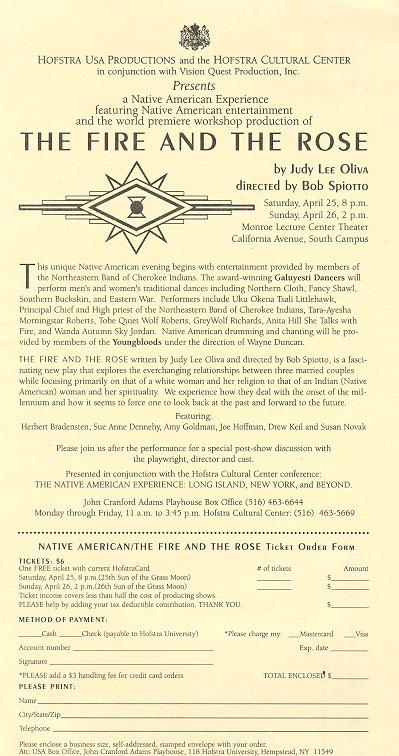
 The Fire and the Rose
The Fire and the Rose
by JudyLee Olivia
- Characters
- Joanie Kozak: late thirties, is part Chickasaw Indian, dark hair and eyes. She wears her hair in one long braid.
- Miles Kozak: her husband, early forties, blond with very blue eyes. He is VP in charge of sales for a large New York City Graphic Arts Company.
- Bernadette Conway: close friend to Joannie, early forties, goes by “Bernie.” She has greenish-blue eyes that stare right through. Teaches literature at a small, private Catholic university in Seattle, but originally from the midwest. Her speech is very precise and direct, reflecting her need to be in control.
- Anthony Conway: her husband, middle forties, prematurely grey, with cloudy eyes. He is head of copying services at the same university. He plays hymns on his upright piano, but he’d rather be playing jazz. Goes by Tony.
- Martha Winston: late twenties, has a very pronounced southern drawl, neighbor to Tony and Bernie; does not work.
- Larry Winston: late twenties, has a pronounced southern drawl, but the accent is “clipped” as he barely moves his mouth when he speaks. Lets Martha do most of the conversing. He is self-employed, owner of a company that builds gauges. The couple have traveled extensively selling their gauges to large companies. Loves to eat and is beginning to acquire a belly.
- Setting
- Most of the action takes place over a period of one year between October of 1998 and 1999 mainly in Seattle, however time has no meaning in some of the scenes as the action moves both in and out of real time and in and out of reality. By the end of the play we are nearing the end of the century.
The set is representational. There should be no attempt at complete realism in any of the scenes. Each scene should flow into the next without blackouts or time lapses. Lights play a pivotal role in realizing the visual style of the play. Glass sculptor Dale Chihuly’s work is the inspiration for the overall look of the landscape. A scrim is necessary or some other device that reveals people and images and separates characters between time and realities. The stage space should be able to transform, very simply, into a beach with an ocean and a breeze, and just as simply transform from that into the front room of Bernie and Tony’s bungalow. This transformation should be magical. There is a feeling, always present, of the ocean — and the elements — earth, wind, fire, and water.
- Summary
- Poet Joanie Kozak wrote in an early poem: “We look for a place/Someplace to belong/To land in, a home/A hand, a hug, base – someplace.” Joannie, like all the other characters in The Fire and the Rose, faces the coming millenium with more questions than answers. “I measured my life by bars of soap,” Joannie, part Chickasaw Indian, tells her best friend Bernie, a professor of literature at a small Catholic university. “I became very aware of the end of things. I made a note each night of how much smaller the soap was. It became a kind of game – who would go first me or the Camay. I never threw the small piece of soap away, like you normally do. It was me, holding on, meaning something, having some worth until the end. Even if it were just the scent.”
Joannie’s death draws the remainder of the characters into the circle, but it is Bernie who must struggle to comprehend not only Joannie’s death, but also the unraveling of her marriage to husband Tony, and the realization that she no longer finds solace in her religion. Bernie is asked to edit Joannie’s last poetry book, and as she does so, Joannie “visits” Bernie. They have four “conversations” about “death, faith, love, life.” Their conversations move out of reality and into the surreal world of thought and ideas, of experience and meaning.
In this full length, six character drama, the scenes run the gamut of emotions, from the humorous portrayal of everyday rituals, to the more absurd exploration of how characters view the coming millenium, to the painful reliving of Joannie’s impending death. All three couples — Joannie and her husband Miles, Tony and Bernie, and their neighbors Martha and Larry, must confront the ultimate issue: the difference between religion and spirituality. “The baby Jesus had no face,” Miles says of his dream; while Tony laments, “I don’t wag my tail for Jesus anymore,” and Joannie admits to Bernie, “I never found God, I hope you do.” Near the end each character attends Joannie’s posthumous book debut and each reads a poem that depicts no only the inner most feeling of each character, but also reveals some insight as to how they face the next century. Martha’s selection reminds her of a time gone by that cannot be recaptured in “Of Thee I Sing.” Larry’s choice is “My Cup Runneth Over,” ironically marking his emptiness. Tony recites “People on the Line,” about how the clothesline is no longer needed anymore. Bernie shares “The Car Salesman’s Daughter,” where we learn that blame is often misplaced. And finally, Miles reads “Rainbow to the Millenium,” a criticism of how society feels such a need to chronicle the millenium, but in the end all the scientific explanations for all we’ve done and all we’ve accomplished mean nothing if we have no one to share them with.
A staged reading of The Fire and the Rose took place at Miami University in Oxford, Ohio in March of 1998. It also received a workshop production at Hofstra University in New York in April of 1998 as a part of the Native American Experience Conference.
Synopsis written by the author.
